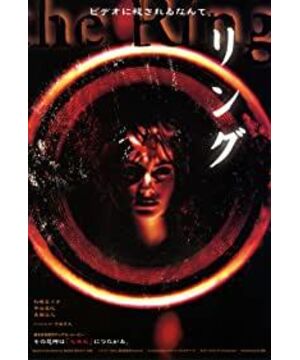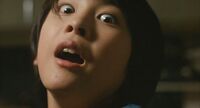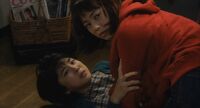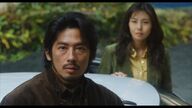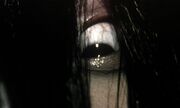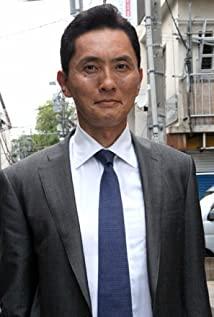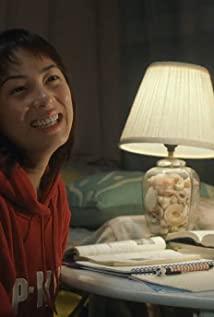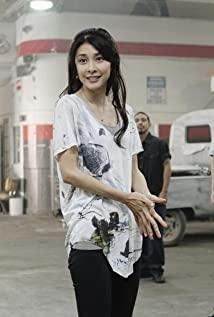At first glance at the midnight bell, you will be shocked by the fear of its media, especially the traditional TV as a way to the other world, which makes it full of gimmicks once it comes out. Therefore, this sense of fear actually comes from the fear of the media. feel. But in fact, the horror of "Midnight Ring" comes from the claustrophobic space created by it. The space created by the film is carefully designed. The lens gives way to the construction of this space. The characters are wandering in the space like ghosts, based on their essence. In other words, it is connected to Kurosawa Kiyoshi's "Circuit" to some extent. And the film is unique in the use of colors, and the details are handled very well.
Ghosts and Mysticism
"Sophon" is the most resident ghost in the film except Sadako. Her existence is a certain connection with Yang Yi. So, how did the first half of the film prove the existence of this ghost through a simple lens?
The above series of pictures is to prove how ghosts exist in movies. The ghost creates a connection with Yangyi, and as the connection is maintained, the character will have a peculiar perception ability. Yang first perceives the existence of Sophon, the dead can use the living to move in the space, and the ghost will bring the connected object The process of entering death is the process of ghost existence. For the ghost body, space is the most important dimension, and time is the most important dimension for the living. This is the difference. Of course, ghosts can not only be felt by Yang Yi. As just said, ghosts have a very strong sense of space. It is difficult to accept foreign objects in a confined space. Therefore, in the film, the current Fron Si appears at home, and it is obvious that you can feel it. Discomfort, this is the aggressiveness brought about by space. Here it is actually confirmed that Sophon, as a ghost body parasitizing Yangyi, has used this space (Yangyi's home) as his own space for existence.
Similarly, Sadako also used this method (it’s just that the medium has changed, no longer a strange gesture between Yoichi and Tomoko, but through a videotape) to establish a connection with Asakawa and Ryuji, so we can feel Sadako Always exist (or appear randomly). Sadako's connection with Ryuji and Asakawa also went through the process of invasion, drive, closure, and death. Especially when they returned to Sadako's birth island, this connection was unprecedentedly strong, and the characters' perception ability was even Substantiated (enter Sadako's intention to kill). This kind of perceptual ability seems to slowly lift the veil of film mysticism. The characters are constantly exploring, or put another way, it is the ghosts constantly exploring. So where is the mysticism of the film? Is it the content of the videotape? Was it the cause of Sadako's death? No, the mysticism of the movie comes from these ghostized and about to be ghosted objects we call people.
Space construction
When it comes to this, I have to emphasize again that the process of "How are ghosts born?" mentioned earlier is the process of space construction. The sense of space in the film is manifested in the establishment of a closed space. The characters take the initiative to enter the closed space until they become accustomed to this space, because closed not only means claustrophobia and fear, but also means a relative sense of security.
Take a clip of the video to see how this space is built.
The character enters the hotel, the door is open, behind the character is a dark staircase, the stairwell is next to the door, and the character glances around the room. It is obvious that the furniture layout of the room is very unreasonable, and the sense of spatial dislocation is very strong, and it is dark at first. obvious. After the character entered the hotel, he searched for the video tape, searched to no avail, and then sat on the sofa.
After entering the hotel and sitting on the sofa, the lens changed slightly. The lens began to advance slowly and came to a close-up position, but at the same time, it slowly covered the fan with characters as it moved. The open door and the deep stairway, such a small detail laid the foundation for the next appearance of the ghost.
After the character sits on the sofa, he picked up a notebook and started to flip it up. But is this lens weird? Why did it use a shoulder lens? There is obviously no one else in the room. If you want to show the contents of the notebook, a close-up shot is obviously more suitable, but there is no one here. It was here that the ghost appeared for the first time, appearing in an unconscious and treacherous way. Of course, this lens does not necessarily refer to this, but the following consecutive lens confirms this.
Immediately after the over-the-shoulder shot, the shot was cut up a bit, as if the staring eyes were starting to move away from the person, keeping a distance, and it was this set of shots that confirmed the existence of this ghost.
Then the characters fell asleep, and the next shot was dinner out. The same problem is that sleep is actually suggesting a conscious space. Sleep is obviously when people are most vulnerable. Suddenly falling asleep in such a room, showing one's most vulnerable posture is also indicative of some situations. In other words, the ghost body regains the dominant power of the space, or the confined space has the ability to corrode and seize.
After dinner, after the characters watched the video, the phone rang. At this time, we can clearly notice that the door is closed, and the stairs are darker, and the whole room begins to present a gloomy atmosphere, but The phone has a light (obviously to highlight the point), and the shadows of the characters begin to appear. Here, this confined space can be said to be completely formed, but in the film, the director deliberately broke through this sense of fear from the claustrophobic space with a sense of panic and at a loss.
After receiving the call, the character puts away the video tape and rushes out of the room after hearing the sound. Here is the character leaving the space voluntarily, but the camera has been facing this space (as shown in the picture). It is obvious that the protagonist of this scene is this Confined spaces, not characters, characters are nothing more than moving furniture. The construction of such a closed space actually provides space for ghosts to rest. For the ghost, space is far more important than time (this is also a question that Kurosawa has always wanted to answer in "The Loop"), because this shot stayed for a long time, not only to remind the house that there is Sadako buried underneath the house The well is also used to photograph the ghosts moving in this house and the claustrophobic feeling of the alternating light and dark in this space. Looking back, the establishment of such a claustrophobic space is completely natural and smooth, and the characters are captured by the space unsuspectingly. This is completely different from the "character accessing space" and "spatial materialization" in The Loop.
This section is selected just to analyze the process of building the space in the movie. In fact, the main way to build the space in the whole movie is not to use such a scene, but to build a virtual, non-physical space. This kind of construction is reflected in the media, and video tapes are an important way to construct this kind of space. When people watch the videotape, they either receive a call or hear sounds from other spaces. From the time they watch the videotape, a distorted space begins to build up. This also answers why the camera cannot capture the faces of these people, because The space is distorted.
This kind of space also answers another question, that is, how did Sadako notify the death and how did Ryuji and Asakawa make a connection? After Ryuuji watched the videotape, Asakawa heard a weird sound on the balcony (this kind of sound later appeared, which is a sign of perception in the space). Even if Ryuuji did not receive the call, it seemed that the sound suggested Ryuji was sentenced to death, so why Asakawa could hear this voice? The reason was that Asakawa was already in this space. When did Ryuji and Asakawa start to have the ability to perceive (be able to see images of the past)? This kind of ability is also available in this space. The construction of this space is entirely dependent on the characters, not the camera. Characters need to have the most basic perception ability to build.
There is another piece of evidence that can show that this space is time-sensitive, and what this space looks like from its establishment to its end. On the small island, Sadako ran to the heroine Asakawa when he killed someone, and left Asakawa in his hands. A trace (here is the above-mentioned ghost materialization and the enhancement of perception ability), but after a week (the end of the well that night) the trace on the hand disappeared, this is actually the disappearance of the distorted space, the space is unconscious Appear and disappear under circumstances.
Another interesting space to build is the blackboard. This is too obvious. The establishment of this virtual space is a wrong accident. The error comes from the fact that Long Si’s student assistant changed the symbols on the blackboard, just like a system. The whole process leads to the establishment of a wrong space. Ryuuji seems to be in this wrong space, because from the later performance, Ryuuji has been saving his ex-wife and son with the purpose of saving himself, but the ending is like this. Like a huge mistake. The critical point of this space lies in Ryuuji’s active error correction. When Ryuuji corrected the error, the system began to operate as normal. Sadako appeared immediately after changing the symbol, so after the end of this disordered space, Longji Secretary has always existed in this distorted space.
Having said all this, let's go back to the original point. Why is this film always building space? From TVs to cars, from dim rooms to cramped cabins, from physical to virtual, and so on. The space built by the film has a certain relationship with the environment Sadako is in. Sadako's environment is a well with a manhole cover. The purpose of the film is to restore this closed and deep environment everywhere. Therefore, Sadako is The child needs a distorted space to realize the transmission of consciousness, and with the help of media such as TV and telephone to realize the jump in space, in the film, people seem to be part of the medium. At the same time, this also answers the question that Kurosawa raised in the loop, if ghosts exist, where is the space for ghosts? If the ghost space is full, where will the ghost go?
The utility of color
This work exerts the effect of color in traditional horror films, and the main color is green. Green generally means "evil, insidious, cunning" and "potentially dangerous" in horror movies. In this movie, we can notice that the female protagonist wears green clothes very frequently, so when did Asakawa start to wear green coats? Asakawa put on a green coat when he went to the log cabin hotel for the first time, which is the scene mentioned above, and here, Asakawa is obviously in a potentially dangerous state.
After that, Asakawa returned home without a coat. It can be understood that there was no particularly strong sense of danger at home. On the other hand, it was also a false relief that the ex-husband did not receive a phone call after watching the video tape. But as the investigation progressed, Asagawa changed into a green coat and sent the child to his grandfather's residence.
But Asakawa didn't always wear green clothes at his grandfather's house. This can also prove Asakawa's psychological hint that this is a safe place. Of course, the next scene is more elaborate.
Son Yang is on the green tatami, the TV in the lower left corner is facing right away, and in front of the camera is the dark bedroom (is it very similar to the scene I mentioned earlier). The special point here is that the room behind has formed a sense of depth, and the whole composition brings a sense of trembling fear (its deep sense of fear has the same effect as the dark stairwells and dark corridors of Tomoko's house).
But this shot did not stay for long before the mother came in (not a static shot with enough space as in the previous scene). At this time, Asakawa did not have a green coat, but a protective white, which proved Asakawa at this time. It appears as a protector. She immediately hugged her son into the bedroom inside, and then closed the door. A closed space was formed here, and this space was protective.
Next, we will see that Yang Yi is obviously in danger, but through this scene, Yang Yi completely reveals the existence of the ghost image of Sophon. In terms of space, when Yang watched the video tape, he was in a closed space. This was from one closed space to another, but from a protective space to a distorted space.
After this scene, Asakawa basically wore green clothes. Until the well water stage, Asakawa took off the green clothes, creating an illusion here, because Asakawa’s escape from danger was hinted here, but the audience would I thought that the part that hugged Sadako's skull was the reason for the escape from danger, but in fact, it was learned from the ending that it had nothing to do with whether or not he hugged the bones. From a color perspective, the clothes that Asakawa wears are deceptive and illusory yellow, which actually proves this point.
The most subtle use of color is in the following scene. Ryuuji sends Asakawa home. After the two get off the car, the car as a closed space is obviously the dividing line between the two spaces. The details are shown in the dragon. The car door on Si's side was open, but Asakawa wore the green coat back to indicate the end of the illusion. Combining the death of Ryuji at the end of the film and the “construction of the wrong space” mentioned above, it can be deduced that Ryuji is always in a confined dark space, and with the end of the “false appearance” of Asakawa’s salvation, Ryuji’s death warning has been quietly completed. Pulling away, the characters return to the constraints of space by inertia, and die as they should.
In fact, when it comes to the effect of color, there is another detail that has to be ignored in the film. When they knocked on the manhole cover, the end of the crowbar held by Ryuuji was red. It is thought that Sadako was held by his father in the film. It hits the head, so the resulting combination reaction is extremely strong.
To sum up, although the use of color in the film is so little that it is almost inconspicuous, everything is accurate and undoubtedly, combined with the sense of space created by the whole film, this film has a sense of fear that penetrates the bones of the bone.
View more about Ringu reviews


